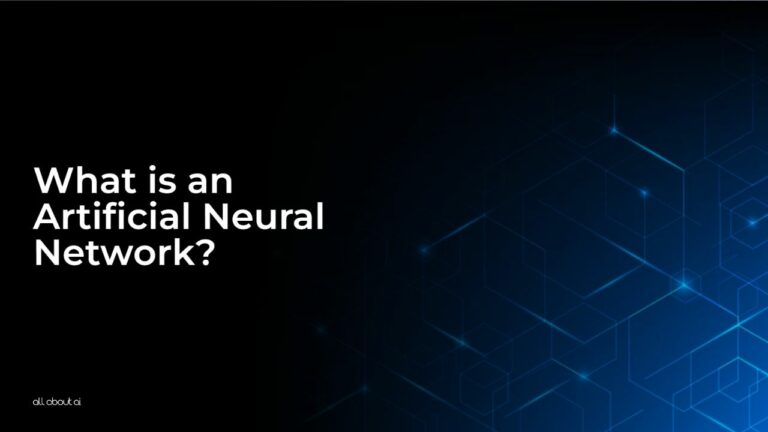An Artificial Neural Network (ANN) is a computational model inspired by the human brain’s neural structure. It consists of interconnected nodes, or “neurons,” organized into layers – the input layer, hidden layers (if any), and the output layer.
Looking to learn more about Artificial Neural Networks? The AI Aces at All About AI have crafted this article to help you deepen your understanding of ANNs.
Examples of Artificial Neural Network
Speech Recognition: Artificial Neural Networks power voice assistants like Siri and Alexa. They process audio data, converting spoken words into text, using deep learning techniques. These networks enable natural interactions with devices, revolutionizing human-computer communication.
Healthcare Imaging: In healthcare, ANNs assist in diagnosing diseases through medical imaging analysis. They identify abnormalities in MRI, CT, and eye scans, enhancing accuracy. Rapid data processing benefits patients by speeding up diagnosis and treatment planning.
Financial Analysis: Financial institutions employ ANNs for stock price prediction and fraud detection. These networks analyze market data and transaction patterns, providing insights for investment decisions and ensuring security by flagging fraudulent activities.
Recommendation Systems: E-commerce platforms and streaming services rely on ANNs for personalized recommendations. These networks analyze user behavior, suggesting products and content that match individual preferences. This enhances user engagement and satisfaction.
Natural Language Understanding (NLU): ANNs drive Natural Language Understanding, enabling sentiment analysis, chatbot interactions, and language translation. They assess text for emotional tone, generate contextually relevant responses, and bridge language barriers effectively.
Use Cases of Artificial Neural Network
Medical Diagnosis and Prognosis: In healthcare, ANNs assist in diagnosing diseases and predicting patient outcomes. They analyze patient data, including symptoms and medical images, facilitating accurate diagnoses and personalized treatment plans.
Predictive Maintenance: Industries use ANNs for predictive maintenance, monitoring equipment sensor data to predict failures. This reduces downtime, minimizes repair costs, and enhances operational efficiency by scheduling maintenance proactively.
Sentiment Analysis in Social Media: Businesses employ ANNs to monitor sentiment in social media. These networks analyze text data to gauge public sentiment, aiding decision-making, shaping marketing strategies, and enhancing customer engagement.
Traffic Management: Smart cities use ANNs for traffic prediction and optimization. These networks process real-time traffic data to forecast congestion, suggest optimal routes, and improve traffic flow, reducing congestion and emissions.
Energy Consumption Optimization: Energy management systems leverage ANNs to optimize electricity use. They analyze sensor data and weather forecasts, adapting energy distribution and consumption to reduce costs and promote sustainability.
Pros and Cons
Pros
- ANNs can adapt and learn from data, making them versatile for various tasks.
- They can process multiple inputs simultaneously, enhancing efficiency.
- ANNs excel at recognizing complex patterns in data.
- They can generalize from training data to make predictions on new data.
- ANNs can model complex, non-linear relationships in data.
Cons
- Creating and training ANNs can be complex and computationally intensive.
- They may perform poorly on new data if overfitting occurs during training.
- ANNs require large datasets for effective training.
- Understanding why an ANN made a specific decision can be challenging.
- Some ANNs require powerful hardware for efficient operation.
FAQs
What is the difference between CNN and ANN?
Convolutional Neural Networks (CNNs) are specialized neural networks designed for image-related tasks, using convolutional layers to detect patterns in images. In contrast, Artificial Neural Networks (ANNs) are general-purpose and fully connected, used for a wide range of tasks beyond image processing.
What is the difference between AI and neural network?
Artificial Intelligence (AI) is a broad field encompassing various technologies and approaches aimed at creating intelligent machines. Neural networks, including Artificial Neural Networks (ANNs), are a subset of AI techniques inspired by the human brain’s neural structure, used for tasks such as pattern recognition and decision-making.
Does artificial neural network mimic the human brain?
Artificial Neural Networks (ANNs) are inspired by the human brain’s neural structure, but they are highly simplified models. They mimic certain aspects of the brain’s information processing, such as learning from data, but are far less complex and lack biological fidelity.
Is ChatGPT a neural network?
Yes, ChatGPT is based on a neural network architecture called GPT (Generative Pre-trained Transformer). It uses a large-scale neural network to generate human-like text and engage in conversations.
What are the problems with artificial neural networks?
Artificial Neural Networks (ANNs) face challenges such as overfitting, which can lead to poor generalization, and the need for large datasets for effective training. They can also lack interpretability, making it challenging to understand their decision-making processes. Additionally, ANNs can be computationally intensive, requiring substantial hardware resources.
What is the future of artificial neural networks?
The future of Artificial Neural Networks (ANNs) looks promising, with ongoing research and advancements. ANNs are expected to play a crucial role in various fields, including healthcare, autonomous vehicles, and natural language processing. Improvements in efficiency, interpretability, and the development of novel architectures will continue to drive their evolution and applications in AI.
Key Takeaways
- Artificial Neural Networks (ANNs) are computational models inspired by the human brain.
- They find applications in speech recognition, healthcare imaging, financial analysis, recommendation systems, and natural language understanding.
- ANNs offer adaptability, parallel processing, and pattern recognition but come with complexities and data dependencies.
- Sentiment analysis in social media and traffic management in smart cities benefit from ANNs’ capabilities.
- ANNs optimize energy consumption, contributing to sustainability goals.
Conclusion
Artificial Neural Networks are the backbone of modern AI, mimicking the neural structure of the human brain to solve complex problems. From speech recognition to predictive maintenance, they have revolutionized various industries. While they offer exceptional adaptability and pattern recognition capabilities, they also come with complexities and dependencies on data.
For a deeper dive into the world of AI and to explore more AI-related terms, keep reading through our AI Technical Terms List, your ultimate resource for AI knowledge.





